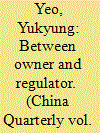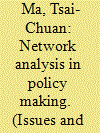| Srl | Item |
| 1 |
ID:
093237


|
|
|
|
|
| Publication |
2009.
|
| Summary/Abstract |
This study explains the institutional structure and mechanism of economic regulation in China's telecommunications basic service industry. The case of telecoms basic service provides an excellent window to explore how Chinese leadership governs strategic state sectors whose assets and profits are central to the national economy. Challenging the ideational model of independent regulator, this study argues that the State-owned Assets Supervision and Administration Commission (SASAC) explains much of the telecoms business regulation, as the authority of the Ministry of Information Industry has been circumscribed by other party-state institutions. The SASAC's regulatory power suggests that the primary goal of the Chinese industrial economy is the best protection of state assets through the creation of large and strong state firms, not the protection of consumers' interests by breaking up the monopoly in markets.
|
|
|
|
|
|
|
|
|
|
|
|
|
|
|
|
| 2 |
ID:
092533


|
|
|
|
|
| Publication |
2009.
|
| Summary/Abstract |
We study the determinants of capital structure for 650 Chinese publicly listed companies over the period from 1999 to 2004. We posit that a firm's decision on capital structure is inherently dynamic, and estimate the resulting dynamic capital structure model. The main findings of the paper are as follows: (i) Chinese firms adjust toward an equilibrium level of debt ratio in a given year at a very slow rate; (ii) firm size, tangibility and state shareholdings are positively associated with firm's leverage ratio, while profitability, non-debt tax shields, growth and volatility are negatively related to firm's leverage ratio; (iii) lagged profitability has a negligibly small and positive impact on firm's leverage ratio; (iv) for a firm experiencing a large reduction in its leverage ratio only about 11% of the discrepancy between its desired and actual leverage level is eliminated within a year (compared to more than 18% for full firm sample); (v) extending the basic model to allow for both the target level and the speed of adjustment to be endogenously determined, we find that Chinese firms tend to adjust faster if they are farther away from the equilibrium leverage level; and lastly (vi) extending the sample period to cover the earlier periods starting from 1993, when the Chinese stock markets were first developed, results in a slower speed of adjustment for firms in the below target sample.
|
|
|
|
|
|
|
|
|
|
|
|
|
|
|
|
| 3 |
ID:
081822


|
|
|